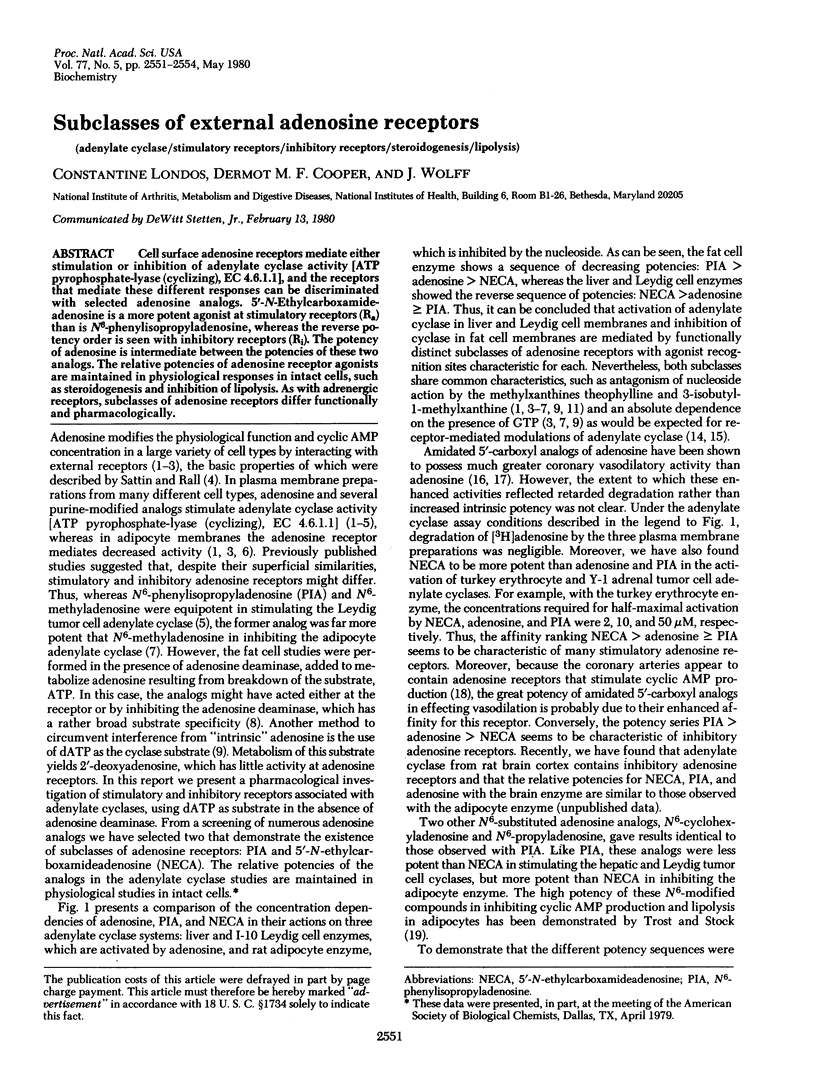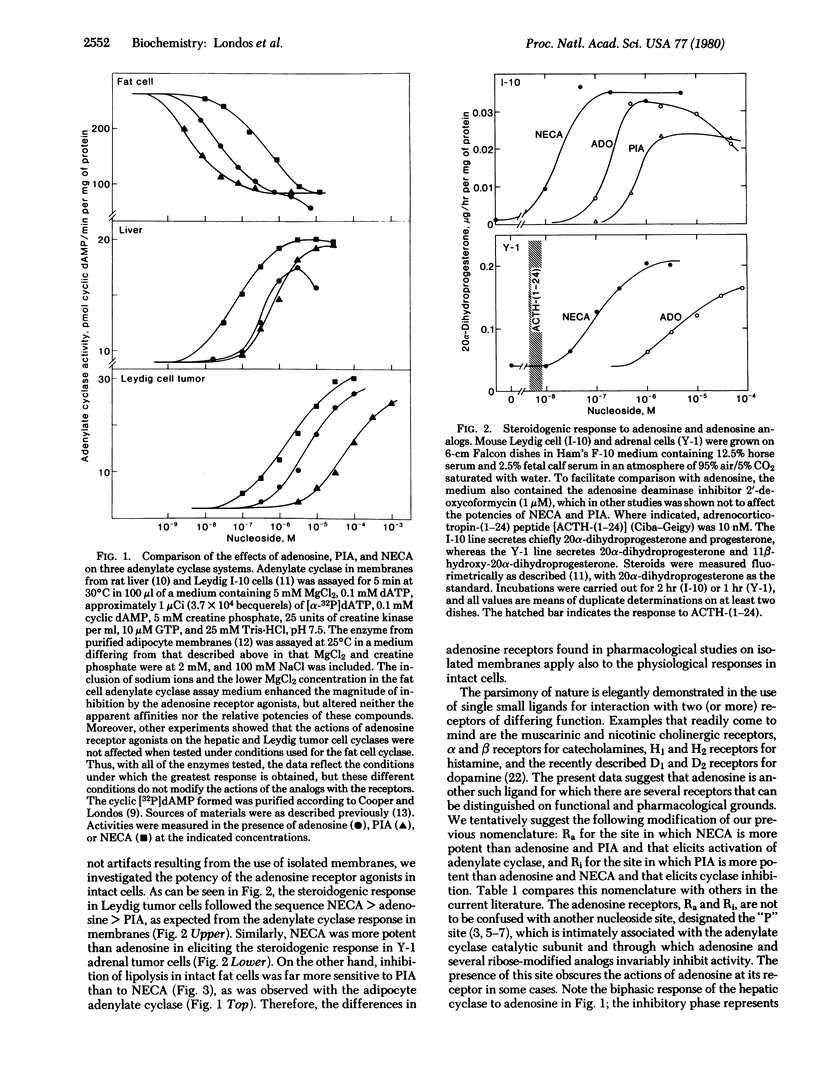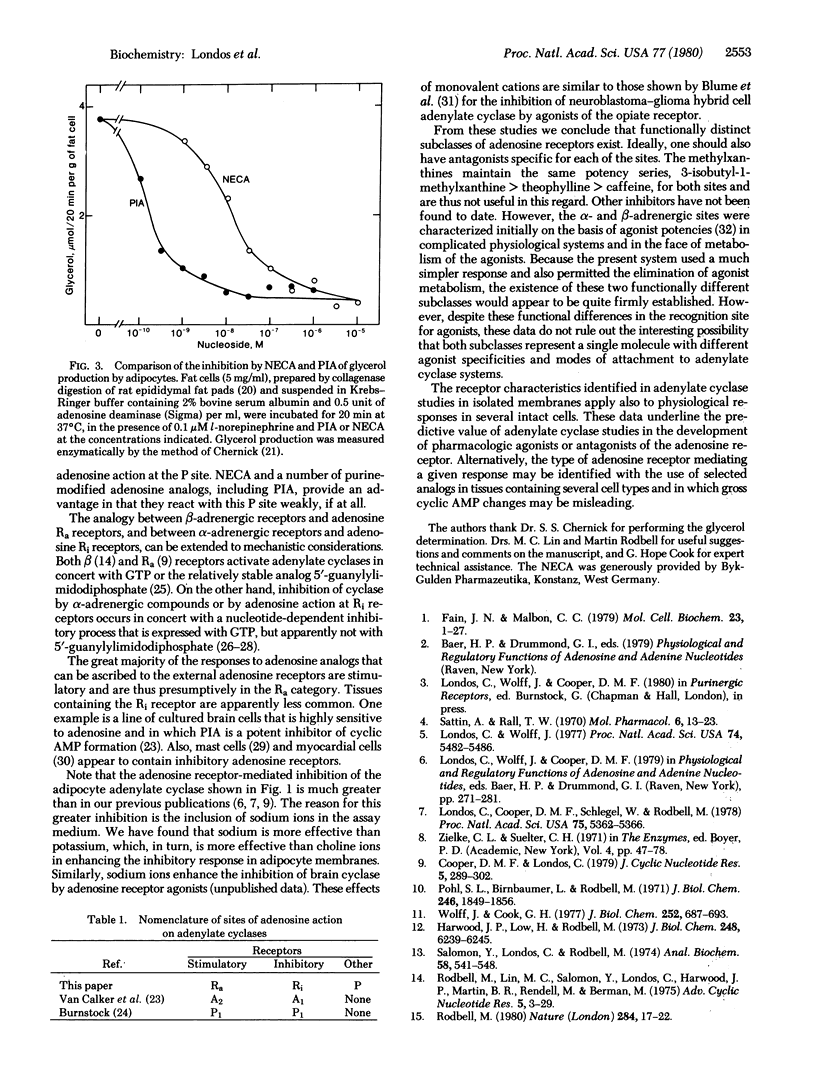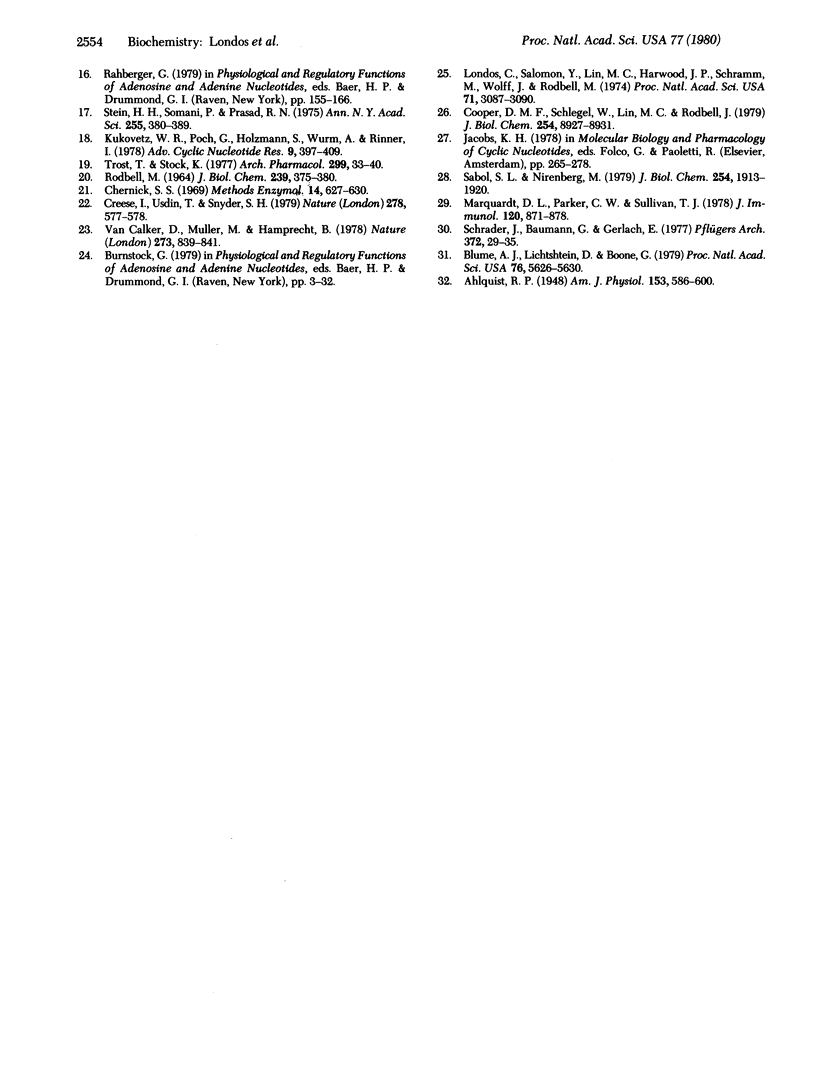Abstract
Cell surface adenosine receptors mediate either stimulation or inhibition of adenylate cyclase activity [ATP pyrophosphate-lyase (cyclizing), EC 4.6.1.1], and the receptors that mediate these different responses can be discriminated with selected adenosine analogs. 5'-N-Ethylcarboxamide-adenosine is a more potent agonist at stimulatory receptors (Ra) than is N6-phenylisopropyladenosine, whereas the reverse potency order is seen with inhibitory receptors (Ri). The potency of adenosine is intermediate between the potencies of these two analogs. The relative potencies of adenosine receptor agonists are maintained in physiological responses in intact cells, such as steroidogenesis and inhibition of lipolysis. As with adrenergic receptors, subclasses of adenosine receptors differ functionally and pharmacologically.
Full text
PDF



Selected References
These references are in PubMed. This may not be the complete list of references from this article.
- Blume A. J., Lichtshtein D., Boone G. Coupling of opiate receptors to adenylate cyclase: requirement for Na+ and GTP. Proc Natl Acad Sci U S A. 1979 Nov;76(11):5626–5630. doi: 10.1073/pnas.76.11.5626. [DOI] [PMC free article] [PubMed] [Google Scholar]
- Cooper D. M., Londos C. Evaluation of the effects of adenosine on hepatic and adipocyte adenylate cyclase under conditions where adenosine is not generated endogenously. J Cyclic Nucleotide Res. 1979;5(4):289–302. [PubMed] [Google Scholar]
- Cooper D. M., Schlegel W., Lin M. C., Rodbell M. The fat cell adenylate cyclase system. Characterization and manipulation of its bimodal regulation by GTP. J Biol Chem. 1979 Sep 25;254(18):8927–8931. [PubMed] [Google Scholar]
- Creese I., Usdin T., Snyder S. H. Guanine nucleotides distinguish between two dopamine receptors. Nature. 1979 Apr 5;278(5704):577–578. doi: 10.1038/278577a0. [DOI] [PubMed] [Google Scholar]
- Harwood J. P., Löw H., Rodbell M. Stimulatory and inhibitory effects of guanyl nucleotides on fat cell adenylate cyclase. J Biol Chem. 1973 Sep 10;248(17):6239–6245. [PubMed] [Google Scholar]
- Kukovetz W. R., Pöch G., Holzmann S., Wurm A., Rinner I. Role of cyclic nucleotides in adenosine-mediated regulation of coronary flow. Adv Cyclic Nucleotide Res. 1978;9:397–409. [PubMed] [Google Scholar]
- Londos C., Cooper D. M., Schlegel W., Rodbell M. Adenosine analogs inhibit adipocyte adenylate cyclase by a GTP-dependent process: basis for actions of adenosine and methylxanthines on cyclic AMP production and lipolysis. Proc Natl Acad Sci U S A. 1978 Nov;75(11):5362–5366. doi: 10.1073/pnas.75.11.5362. [DOI] [PMC free article] [PubMed] [Google Scholar]
- Londos C., Salomon Y., Lin M. C., Harwood J. P., Schramm M., Wolff J., Rodbell M. 5'-Guanylylimidodiphosphate, a potent activator of adenylate cyclase systems in eukaryotic cells. Proc Natl Acad Sci U S A. 1974 Aug;71(8):3087–3090. doi: 10.1073/pnas.71.8.3087. [DOI] [PMC free article] [PubMed] [Google Scholar]
- Londos C., Wolff J. Two distinct adenosine-sensitive sites on adenylate cyclase. Proc Natl Acad Sci U S A. 1977 Dec;74(12):5482–5486. doi: 10.1073/pnas.74.12.5482. [DOI] [PMC free article] [PubMed] [Google Scholar]
- Marquardt D. L., Parker C. W., Sullivan T. J. Potentiation of mast cell mediator release by adenosine. J Immunol. 1978 Mar;120(3):871–878. [PubMed] [Google Scholar]
- Pohl S. L., Birnbaumer L., Rodbell M. The glucagon-sensitive adenyl cyclase system in plasma membranes of rat liver. I. Properties. J Biol Chem. 1971 Mar 25;246(6):1849–1856. [PubMed] [Google Scholar]
- RODBELL M. METABOLISM OF ISOLATED FAT CELLS. I. EFFECTS OF HORMONES ON GLUCOSE METABOLISM AND LIPOLYSIS. J Biol Chem. 1964 Feb;239:375–380. [PubMed] [Google Scholar]
- Rodbell M., Lin M. C., Salomon Y., Londos C., Harwood J. P., Martin B. R., Rendell M., Berman M. Role of adenine and guanine nucleotides in the activity and response of adenylate cyclase systems to hormones: evidence for multisite transition states. Adv Cyclic Nucleotide Res. 1975;5:3–29. [PubMed] [Google Scholar]
- Rodbell M. The role of hormone receptors and GTP-regulatory proteins in membrane transduction. Nature. 1980 Mar 6;284(5751):17–22. doi: 10.1038/284017a0. [DOI] [PubMed] [Google Scholar]
- Sabol S. L., Nirenberg M. Regulation of adenylate cyclase of neuroblastoma x glioma hybrid cells by alpha-adrenergic receptors. I. Inhibition of adenylate cyclase mediated by alpha receptors. J Biol Chem. 1979 Mar 25;254(6):1913–1920. [PubMed] [Google Scholar]
- Salomon Y., Londos C., Rodbell M. A highly sensitive adenylate cyclase assay. Anal Biochem. 1974 Apr;58(2):541–548. doi: 10.1016/0003-2697(74)90222-x. [DOI] [PubMed] [Google Scholar]
- Sattin A., Rall T. W. The effect of adenosine and adenine nucleotides on the cyclic adenosine 3', 5'-phosphate content of guinea pig cerebral cortex slices. Mol Pharmacol. 1970 Jan;6(1):13–23. [PubMed] [Google Scholar]
- Schrader J., Baumann G., Gerlach E. Adenosine as inhibitor of myocardial effects of catecholamines. Pflugers Arch. 1977 Nov 25;372(1):29–35. doi: 10.1007/BF00582203. [DOI] [PubMed] [Google Scholar]
- Stein H. H., Somani P., Prasad R. N. Cardiovascular effects of nucleoside analogs. Ann N Y Acad Sci. 1975 Aug 8;255:380–389. doi: 10.1111/j.1749-6632.1975.tb29246.x. [DOI] [PubMed] [Google Scholar]
- Trost T., Stock K. Effects of adenosine derivatives on cAMP accumulation and lipolysis in rat adipocytes and on adenylate cyclase in adipocyte plasma membranes. Naunyn Schmiedebergs Arch Pharmacol. 1977 Aug;299(1):33–40. doi: 10.1007/BF00508634. [DOI] [PubMed] [Google Scholar]
- Wolff J., Cook G. H. Activation of steroidogenesis and adenylate cyclase by adenosine in adrenal and Leydig tumor cells. J Biol Chem. 1977 Jan 25;252(2):687–693. [PubMed] [Google Scholar]


